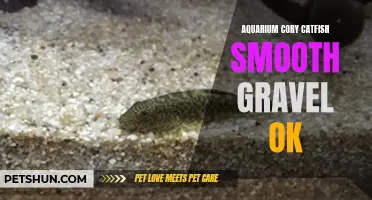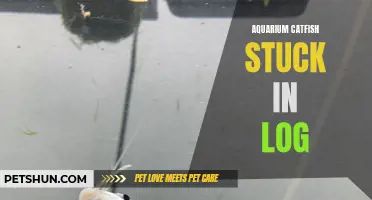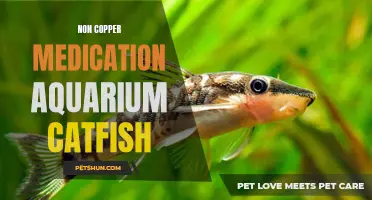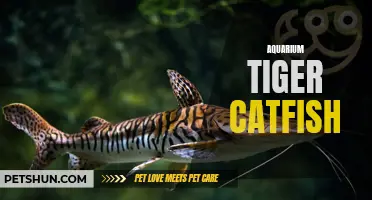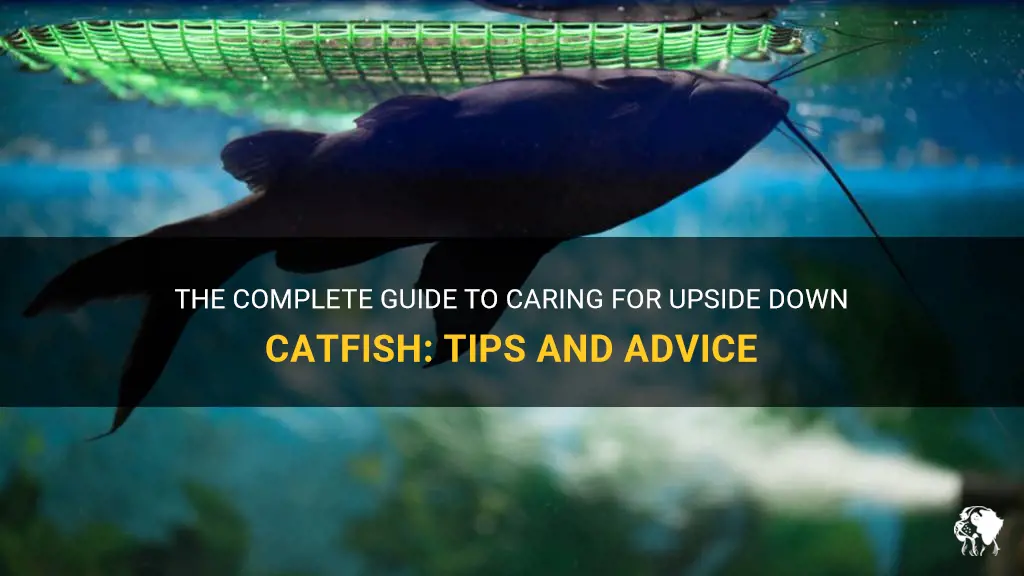
Are you a fish enthusiast looking for a unique and intriguing addition to your aquarium? Look no further than the upside down catfish! This fascinating species of catfish is known for its peculiar habit of swimming upside down, defying gravity in the most mesmerizing way. However, caring for upside down catfish requires specific attention and knowledge to ensure their well-being. In this article, we will explore the various aspects of upside down catfish care, from their dietary needs to their ideal tank setup, so you can provide the best environment for these extraordinary creatures. So, let's dive into the world of upside down catfish care and discover how to create a captivating home for them!
| Characteristics | Values |
|---|---|
| Scientific Name | Synodontis nigriventris |
| Common Names | Upside Down Catfish |
| Size | 2-4 inches |
| Tank Size | Minimum 20 gallons |
| Lifespan | 10-15 years |
| Water Temperature | 74-78°F |
| Water pH | 6.5-7.5 |
| Water Hardness | 2-15 dGH |
| Diet | Omnivorous |
| Tankmates | Peaceful fish |
| Behavior | Bottom-dwelling, social |
| Care Level | Easy |
| Tank Setup | Plenty of hiding spots, driftwood, and plants |
| Breeding | Difficult, requires special conditions |
| Compatibility | Can be kept with small to medium-sized community fish |
| Maintenance | Regular water changes, good filtration |
| Ideal for | Beginner to intermediate aquarists |
What You'll Learn
- What is the ideal tank size and setup for upside-down catfish?
- What kind of water conditions do upside-down catfish require?
- What should upside-down catfish be fed, and how often?
- Are there any specific tank mates to avoid when keeping upside-down catfish?
- How can I provide hiding places and caves for upside-down catfish in the aquarium?

What is the ideal tank size and setup for upside-down catfish?
When it comes to keeping upside-down catfish in captivity, providing them with the proper tank size and setup is crucial for their health and overall well-being. These unique catfish are named for their habit of swimming upside-down, with their bellies facing upwards, and they require specific conditions to thrive in an aquarium environment.
The ideal tank size for upside-down catfish is a minimum of 20 gallons. This provides enough space for them to swim and explore, as well as ample room for their tankmates if you choose to have any. It's important to keep in mind that these catfish can grow up to 4 inches in length, so a larger tank may be necessary for adult specimens.
In terms of the tank setup, upside-down catfish are native to African freshwater rivers and lakes, so it's important to try to replicate their natural habitat as closely as possible. This means providing them with a well-filtered tank that is kept at a stable temperature between 75 and 82 degrees Fahrenheit (24 and 28 degrees Celsius). The pH level should be kept around 6.5 to 7.5, which is slightly acidic to neutral.
To create a suitable environment for these catfish, it's advisable to use fine sand or gravel as the substrate. This will allow them to dig and forage for food, as they would in the wild. Decorating the tank with driftwood and rocks will also provide hiding places and create a more natural-looking habitat. The addition of live plants, such as Anubias or Java Fern, can also enhance the tank's aesthetic and provide additional cover for the catfish.
Upside-down catfish are primarily bottom-dwellers, so it's important to provide them with hiding spots and caves to retreat to. These can be created using PVC pipes or clay pots, ensuring that they are spaced apart to allow for easy movement and prevent territorial disputes. Additionally, providing them with caves made from natural materials such as coconut shells can add an interesting feature to the tank.
In terms of tankmates, upside-down catfish are generally peaceful and can be kept with other peaceful fish that inhabit similar water parameters. Examples of suitable tankmates include tetras, rasboras, and peaceful dwarf cichlids. However, it's important to avoid keeping them with overly aggressive or territorial species, as these can cause stress or harm to the catfish.
Upside-down catfish are omnivorous and will eat a varied diet that includes both plant matter and small invertebrates. Providing them with a mix of high-quality sinking pellets or wafers, as well as frozen or live foods such as bloodworms, brine shrimp, or daphnia, will help ensure a balanced diet. It's important to feed them small amounts multiple times a day, as they have small stomachs and can easily become constipated if overfed.
In conclusion, the ideal tank size for upside-down catfish is a minimum of 20 gallons, with larger tanks being advisable for adult specimens. Creating a suitable environment with a well-filtered tank, stable temperature, and appropriate pH level is essential for their health. Providing hiding spots, caves, and a varied diet will help ensure their well-being and enable them to exhibit their unique upside-down swimming behavior. By following these guidelines, you can create a thriving and interesting aquarium for your upside-down catfish.

What kind of water conditions do upside-down catfish require?
Upside-down catfish, also known as Synodontis nigriventris, are unique and fascinating freshwater fish that can be a great addition to your aquarium. As their name suggests, they have a habit of swimming upside down, which is quite entertaining to watch.
When it comes to water conditions, upside-down catfish are not too demanding. However, it's important to provide them with optimal conditions to ensure their health and well-being. Here are some key considerations for their water requirements:
- Temperature: Upside-down catfish are native to Africa, specifically the Congo Basin, where water temperatures can be warm. Therefore, it is recommended to keep the water temperature between 75-82°F (24-28°C) for these fish. It's crucial to maintain a stable temperature, as sudden fluctuations can stress the fish and make them more susceptible to diseases.
- PH Level: Upside-down catfish prefer slightly acidic to neutral water conditions. The optimal pH range for these fish is around 6.5-7.5. It's a good idea to test the pH of your aquarium water regularly and make adjustments if necessary. You can use pH buffers or additives specifically designed for freshwater aquariums to maintain the desired pH level.
- Hardness: These catfish are adaptable and can tolerate a wide range of water hardness levels. However, they generally prefer moderately hard water. Aim for a water hardness level between 8-12 dGH (degrees of general hardness) for optimal conditions. Again, it's important to monitor the hardness of the water periodically and make adjustments as needed.
- Filtration: Good water filtration is essential for upside-down catfish. As bottom-dwelling fish, they produce a significant amount of waste, and the water quality must be maintained at high standards to prevent the accumulation of harmful substances. A powerful and efficient filtration system is recommended, including mechanical, biological, and chemical filtration components. Regular water changes of about 20-30% every couple of weeks will also help maintain good water quality.
- Oxygenation: Upside-down catfish require well-oxygenated water due to their bottom-dwelling nature. Use an air pump or a water pump with a venturi valve to increase oxygen levels in the aquarium. Additionally, providing ample surface agitation, such as through the use of an airstone or the flow from the filter outlet, can help improve oxygen exchange.
- Tank Size: These catfish are relatively small, reaching up to 4 inches (10 cm) in length. However, they are active fish and appreciate plenty of swimming space. A minimum tank size of 20 gallons (75 liters) is recommended for a small group of upside-down catfish. Providing hiding places with plants or caves will also make them feel more secure and at ease.
It's crucial to remember that fish species may vary slightly in their specific water requirements. Therefore, always research and consult reputable sources or experienced aquarists to ensure you are providing the best conditions for your upside-down catfish.
In conclusion, upside-down catfish are generally adaptable and can thrive in a wide range of water conditions. However, maintaining a stable temperature, pH level, and water hardness, along with proper filtration and oxygenation, are crucial for their well-being. By creating and maintaining optimal water conditions, you can enjoy these unique and entertaining fish in your aquarium.

What should upside-down catfish be fed, and how often?
Upside-down catfish, also known as Synodontis nigriventris, are a popular freshwater aquarium fish. They are unique in that they are adapted to swim upside down and have a specialized mouth that allows them to feed from the surface of the water. To keep your upside-down catfish healthy and happy, it is important to provide them with a proper diet and feed them the right amount and frequency.
In the wild, upside-down catfish feed on a variety of foods, including insects, small crustaceans, and plant matter. In captivity, it is important to replicate their natural diet as closely as possible. This can be achieved by offering a mixture of live or frozen foods and high-quality dried foods.
Live or frozen foods that are suitable for upside-down catfish include brine shrimp, bloodworms, daphnia, and mosquito larvae. These foods can be purchased from pet stores or bred in captivity. Offering a variety of these foods will ensure that your catfish receives a balanced diet.
In addition to live or frozen foods, it is also important to offer high-quality dried foods that are specifically formulated for catfish. These foods should be labeled as sinking pellets or tablets, as upside-down catfish prefer to feed from the substrate rather than the surface of the tank. Look for foods that contain high levels of protein and vitamins to support the health of your catfish.
When it comes to feeding frequency, upside-down catfish should be fed small amounts multiple times a day. This is because they have a relatively small stomach and can't consume large quantities of food at once. Ideally, you should aim to feed your catfish 2-3 times a day, giving them only as much food as they can consume within a few minutes.
Overfeeding can lead to health issues such as obesity and poor water quality, so it is important to monitor your catfish's feeding habits and adjust the amount of food accordingly. A good rule of thumb is to offer an amount of food that can be consumed within 3-5 minutes. If there is any uneaten food after this time, it should be removed from the tank to prevent it from decomposing and polluting the water.
To ensure that your upside-down catfish receive all the essential nutrients they need, you can also consider adding a commercial fish food supplement to their diet. These supplements are often in the form of tablet or pellet and can be added to their regular diet. They are designed to provide additional vitamins and minerals that may be lacking in their primary food sources.
In conclusion, upside-down catfish should be fed a balanced diet consisting of live or frozen foods and high-quality dried foods. Feeding them small amounts multiple times a day will help prevent overfeeding and maintain good water quality. Offering a variety of foods and supplementing their diet with commercial fish food supplements will ensure that your catfish receive all the essential nutrients they need to thrive.

Are there any specific tank mates to avoid when keeping upside-down catfish?
When it comes to keeping upside-down catfish as pets, it is important to consider the compatibility of tank mates. While upside-down catfish are generally peaceful and easygoing, there are certain tank mates that may not be a good fit for them due to differences in size, behavior, or water parameters. Here are some tank mates to avoid when keeping upside-down catfish:
Aggressive fish:
Upside-down catfish should not be kept with aggressive or territorial fish species. These types of fish can stress out the upside-down catfish, leading to poor health and behavior. Examples of aggressive fish to avoid include cichlids, some barbs, and certain types of freshwater puffers.
Fin-nipping fish:
Upside-down catfish have long, flowing fins that can easily be targeted by fin-nipping fish. Species like tiger barbs and serpae tetras are notorious for nipping at the fins of other fish, and they can cause stress and injury to the upside-down catfish. It is best to avoid keeping these types of fish together.
Large predators:
Upside-down catfish are relatively small compared to some other fish species, so it is important to avoid keeping them with large predatory fish. Predatory fish may see the upside-down catfish as potential prey and can cause harm or even eat them. Examples of popular predatory fish include certain species of cichlids, large catfish, and aggressive fish from the pike family.
Bottom-dwelling fish with similar diets:
Upside-down catfish are primarily bottom-dwelling fish that feed on detritus and small invertebrates in the substrate. It is important to avoid keeping them with other bottom-dwelling fish that have similar feeding habits and diets. Competition for food can lead to stress and malnutrition for the upside-down catfish. Examples of bottom-dwelling fish that may not be compatible include loaches and some types of catfish.
Fish with different water parameter requirements:
Upside-down catfish are native to Africa and are adapted to specific water parameters. It is important to consider the water requirements of any potential tank mates to ensure compatibility. Fish that prefer vastly different water conditions, such as different pH or temperature ranges, may not be suitable companions for the upside-down catfish.
In conclusion, while upside-down catfish are generally peaceful and compatible with a wide range of fish species, there are certain tank mates to avoid for their well-being. Aggressive and fin-nipping fish, large predators, bottom-dwellers with similar diets, and fish with different water parameter requirements should be avoided to ensure a harmonious and stress-free tank environment for the upside-down catfish.

How can I provide hiding places and caves for upside-down catfish in the aquarium?
Upside-down catfish (Synodontis spp.) are unique and fascinating inhabitants of aquariums. As their name suggests, these catfish have the ability to swim upside down due to their specialized physiology. Providing hiding places and caves for upside-down catfish is important for their mental well-being and overall health.
In their natural habitat, upside-down catfish are primarily found in African rivers and streams. They inhabit areas with lots of vegetation, fallen branches, and underwater caves. Recreating a similar environment in the aquarium is crucial for the upside-down catfish to thrive.
Here are some steps on how you can provide hiding places and caves for your upside-down catfish:
- Aquascape with vegetation: Adding live plants to your aquarium not only enhances its aesthetics but also provides hiding places for your catfish. Opt for plants that have broad leaves or dense foliage, such as Java fern, Anubias, or Amazon sword. These plants offer hiding spots while also creating a natural and soothing environment.
- Driftwood and branches: Upside-down catfish love to explore and hide among driftwood and branches. Place a few pieces of driftwood or branches in the aquarium to create natural hiding places and caves. Make sure to use aquarium-safe wood and thoroughly clean it before placing it in the tank.
- Artificial caves and hiding spots: If live plants and natural materials are not an option for your aquarium, you can also opt for artificial caves and hiding spots. Many pet stores sell resin caves, tunnels, and tubes specifically designed for aquariums. These provide excellent hiding places for your catfish and can add an interesting focal point to your tank.
- Adding rocks and stones: Another way to create hiding places for upside-down catfish is by using rocks and stones. Arrange the rocks in a way that creates small crevices and gaps, providing the catfish with spaces to hide. Make sure the rocks are stable and won't topple over, potentially harming the fish.
- Multiple hiding spots: It's important to create multiple hiding spots and caves throughout the aquarium. This ensures that each fish has its own territory and space to retreat. Spacing out the hiding spots also helps create a more natural and dynamic setup.
Examples of hiding places and caves for upside-down catfish in the aquarium include dense plant clusters where the fish can weave through, a large piece of driftwood with hollowed-out sections, or a setup with several small caves made from rocks and stones. These hiding places should be spread out across the aquarium to provide ample hiding spots for all the catfish.
In conclusion, providing hiding places and caves for upside-down catfish in the aquarium is essential for their well-being. Creating a natural environment with live plants, driftwood, rocks, and artificial hiding spots ensures that the catfish can exhibit their natural behaviors and feel secure. By following these steps and customizing your aquarium, you can create a thriving habitat for your upside-down catfish.
Frequently asked questions
Upside down catfish are omnivores and eat a variety of foods. They will eat sinking pellets or flakes, as well as live or frozen foods such as bloodworms or brine shrimp.
Upside down catfish should be fed once or twice a day, with only as much food as they can consume in a few minutes. Overfeeding can lead to health problems and poor water quality.
Yes, upside down catfish are tropical fish and require a stable water temperature between 75-82°F (24-28°C). A heater should be used to maintain this temperature.
Yes, upside down catfish are generally peaceful and can be kept with other peaceful fish that are of similar size. Avoid keeping them with aggressive or fin-nipping species.
It is recommended to perform regular water changes of 25% to 50% every 1-2 weeks to maintain good water quality for upside down catfish. The tank should also be cleaned regularly to remove any debris or waste.


